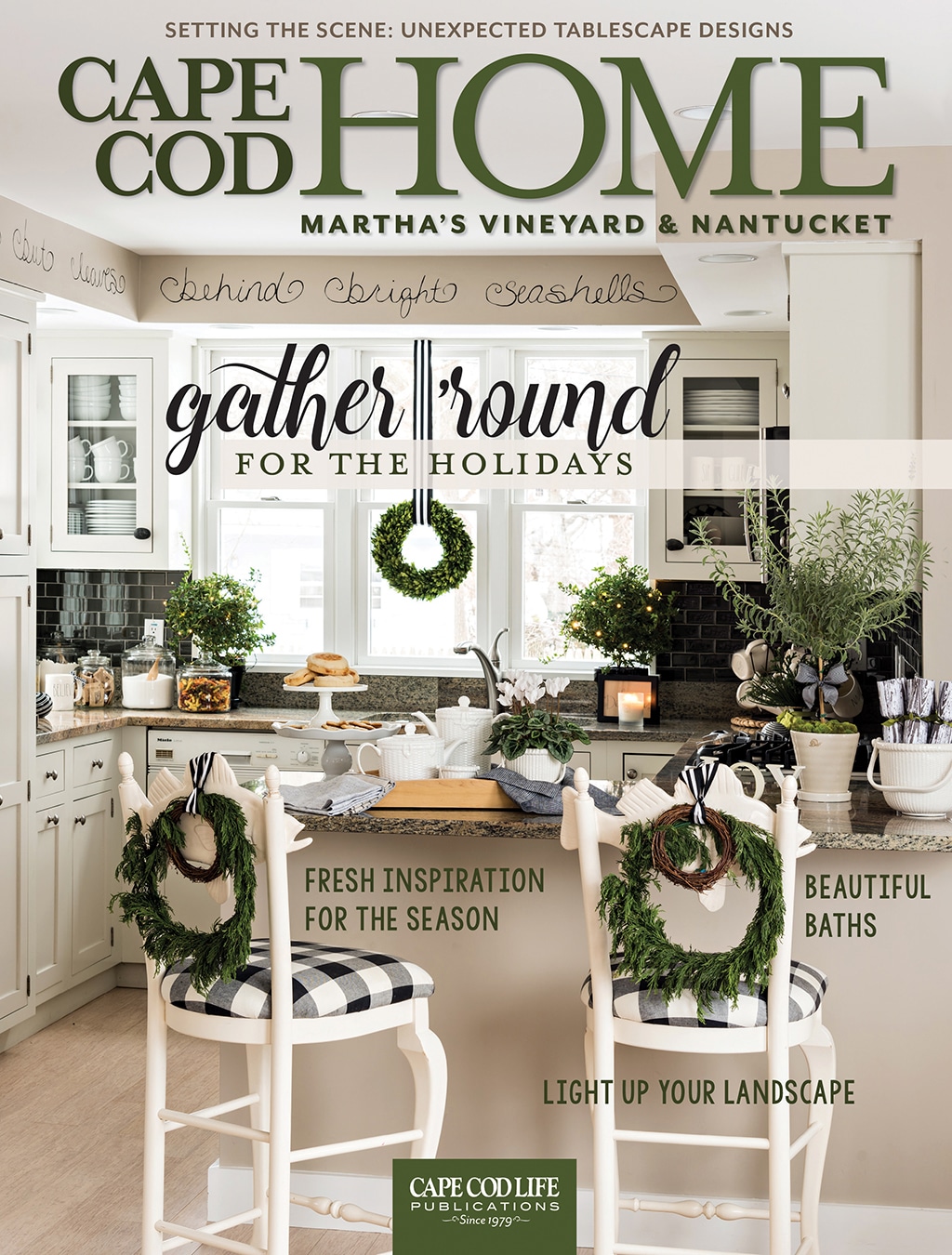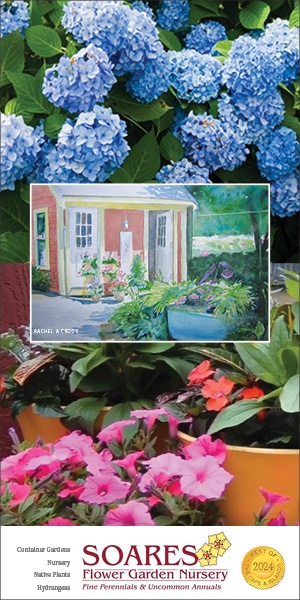
In the Eye of the Beholder
Cape Cod Home / Winter 2018 / Home, Garden & Design, People & Businesses
Writer: Chris White / Photographer: Brian Vanden Brink
In the Eye of the Beholder

Cape Cod Home / Winter 2018 / Home, Garden & Design, People & Businesses
Writer: Chris White / Photographer: Brian Vanden Brink
Life imitates art, and art imitates life, in the transformation of one family’s Harwich Port home
In Shakespeare’s final play, “The Tempest,” the sorcerer Prospero and his servant, a magical spirit named Ariel, create the illusion of a fierce storm that appears to wreck the ship carrying the king of Naples, his son Ferdinand, other dignitaries and the crew. Though no soul actually perishes, Ariel separates the characters into different groups. Some of the men fall into enchanted sleep, while others must try to make sense of the bewildering world of Prospero’s desert island. To heighten the disorientation and loss in the mind of Prince Ferdinand, Ariel sings the following lyrics: “Full fathom five thy father lies; / Of his bones are coral made; / Those are pearls that were his eyes: / Nothing of him that doth fade, / But doth suffer a sea-change / Into something rich and strange.” It’s a mean trick, as the prince believes that his father has perished, but the song does contain an important truth—the king, very much alive, will undergo a radical, positive transformation, a “sea-change,” as will nearly every character in the story.
One interpretation of “The Tempest” claims that Prospero represents Shakespeare himself, and that the magic and illusion in the play represent art. And one of the mysteries of great art is its inherent quality that allows for a range of meaning. Thus, scholars continue to analyze the Bard’s work over 400 years after his death, and the understanding of his stories, while universal in some respects, changes through generations of readers. Though the grand ideas of literature may seem to lie far from the shores of Cape Cod, disconnected from its weathered dwellings, some architects, builders and designers draw inspiration from the same creative well that slaked Shakespeare’s thirst. One firm that seeks to create art in the form of homes is Polhemus Savery DaSilva Architects Builders (PSD) of East Harwich, and one of its recent masterpieces, a home in Harwich Port, alludes directly to Shakespeare’s magical tempest in both its appearance and its name—“Sea Change.”

Sea Change, like many of its interior and exterior features, is both a work of transformation and a statement about the concept of transformation. On a literal level, the house would seem at home in many traditional neighborhoods on the Cape. Its shingles and white trim would allow it to camouflage easily. Yet its lines are more dynamic than the average; its peaks and curves make it stand out and evoke other concepts. In other words, while it’s a house, it also allows the observer to associate with it other forms. For instance, from the street, it might look like a ship, a galleon, with a arc at the “stern” that suggests the captain’s quarters. Its bold windows further support this interpretation, as do the peaks of its three gables, which rise like masts carrying full sail. The gable farthest from the stern swoops into a curve that resembles the confluence of a jib and a bowsprit. Like a galleon, the home appears both ornate and practical, ready to set sail, yet grounded in its proper place.
John DaSilva, design principal at PSD, deployed the architectural idea of associationism when the firm conceived and built Sea Change. He explains, “Associationism is related to symbolism, but it requires more interpretation. Forms imply other things outside the reality of the building itself. This possibility of multiple readings makes it richer.” In other words, it’s an art of illusion, of magic—which places DaSilva and his team, to extend the home’s foundation of allusion, in the roles of Prospero and Ariel. “It’s a way to do something fresh and contemporary but not be too abstract,” says DaSilva. “Where one person may see a ship, another might see a mountain range or a pool slide. Where you might see a port hole in the round window, someone else may see the eye of a fish. This is intentional in what we design. The home takes on another character at night, too, as the profile becomes very prominent—almost as if you stood up an architectural drawing.”
PSD is a fully integrated firm that takes care of nearly every facet of creating a new home. DaSilva says, “We build virtually everything we design and we design virtually all that we build. We’re one-stop shopping, which is easier for clients; they never have to mediate between the architect and the builder.” The homeowners of Sea Change concur, stating, “It was extremely helpful to be able to have all the parties involved at the same table helping each other so the right decisions are made. And on the construction side, they’re true craftsmen, very skilled at what they do, people who take the utmost pride in their work.”

One of the reasons the homeowners and PSD chose “Sea Change” as the name for their home arises from another meaning of the expression. In the business world, a sea change is also a transformation, but often one that is systemic. The term is somewhat interchangeable with a paradigm shift. The homeowners began their time in Harwich Port, on this lot, in a purely summer home. “It was an old beach house, built in 1929, and we’d been using it for about 10 years,” the owner says. “In 2013, we were ready to do something more permanent, though, and it wasn’t the house for that.” After the family moved into their newly rebuilt home, they explored the meanings of “sea change” further and were pleased to find that its original use, from Ariel’s Song, fit thematically with what PSD had accomplished.
Though they still work in the Boston area, the owner notes: “We spend most weekends here year-round now. There’s so much that we love about the house; the layout is just so accommodating to all ages.” On the first floor, rather than using walls to divide space into rooms, PSD created a number of distinct features that partially separate key areas. One might think of these serving like rocks in a stream, interrupting the flow of water, or like a small archipelago—which, of course, extends “The Tempest” reference. DaSilva says: “I don’t mind the thought that there are multiple islands. For instance, the fireplace and built-in shelves are free standing.” The latter contains structural columns at either end and provides storage cabinets in the lower portion of the piece along with shelves that allow for the display of photos, ceramics, and other items or artwork. “It’s articulated more like a piece of large furniture,” he explains.

While the storage/display unit partially frames the living space and separates it from the stairs and den at the back of the home, an airy arcade, in its series of four columns, forms a border with the entrance hall. The kitchen/dining space, with cabinetry designed by Classic Kitchens & Interiors, and living room lie on long, perpendicular axes. DaSilva notes, “The fireplace provides a transition, a knuckle; it’s a freestanding object and a partial barrier between the two spaces.” Set on an obtuse 130-degree angle from the shelves, the turn the fireplace makes also lines up with the pattern on the ceiling and points toward the side-yard-facing porch. The overall layout allows for circulation as well as social flow. Says DaSilva, “You can be in the kitchen or in the living space and still feel connected.” This is true of the dining area, as well; it inhabits a space with wraparound windows at the back side of the kitchen, to which it remains completely open. Says the homeowner: “Having the two islands in the kitchen is really great for us, having two cooks in the family. We also enjoy the banquette, near the fireplace—it’s nice to sit there and have coffee, to watch the comings and goings on the street.” Other elements of the layout include the location of the master bedroom on the first floor, which, says the owner, “works really well for us,” and three other bedrooms upstairs. In the southwest corner of the second floor is a game room, which notably contains no television. Family and friends use this space for board games or playing cards.
When the owners approached PSD, they wanted in Sea Change a shingle-style home with Classical design. However, says the homeowner, “We really stressed to John that we were open to anything—that he should use his imagination and also consider the neighborhood. He pulled it together such that the house leaves people to interpret meaning—like art.” The final result draws upon tradition—for instance, DaSilva points out that shingle-style is the first American architectural invention, appearing in the late 19th century—yet contains contemporary and whimsical elements that he says “cause observers to first wonder and then smile.”

The most obvious example of DaSilva’s intent is probably the entrance to Sea Change, where a robin’s egg blue door nests behind the frame of two columns and an archway. However, as DaSilva points out, “The columns are not real classical columns. They are references to the classical. They are flattened, which makes them more interesting, unique and contemporary—playful, not stodgy.” Likewise, the archway refers to the familiar while allowing for other effects. “There’s a sort of incompletion,” he says, “with one full arch and hints of two others. Or one might see two brackets that spring from the top of the columns, or fountains, or torches.”
The use of “multi-thematic architecture,” explains DaSilva, “is more reflective of our modern world, more consistent with our era.” The home’s exterior has a “taut skin” into which both the entrance porch and the larger side porch have been “incised.” He says: “The effect is subtractive rather than additive. There are multiple reasons for doing this: it’s efficient for mass, for the footprint, for the use of the roof, and it helps keep the house looking fresh and of our day rather than of a different era. And yet it’s still compatible with Greek Revival and other styles common to the Cape.” The sea change from a simple beach house to this dynamic Harwich Port home truly displays, as Ariel sings in “The Tempest,” a metamorphosis “Into something rich and strange.”


















